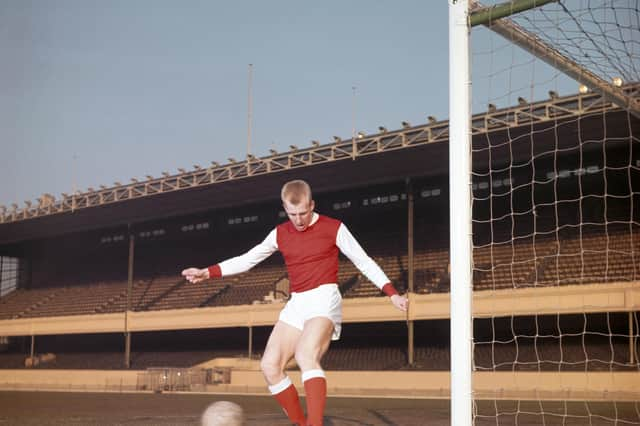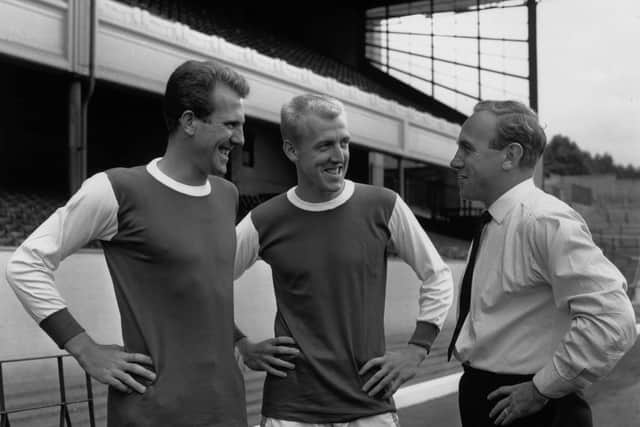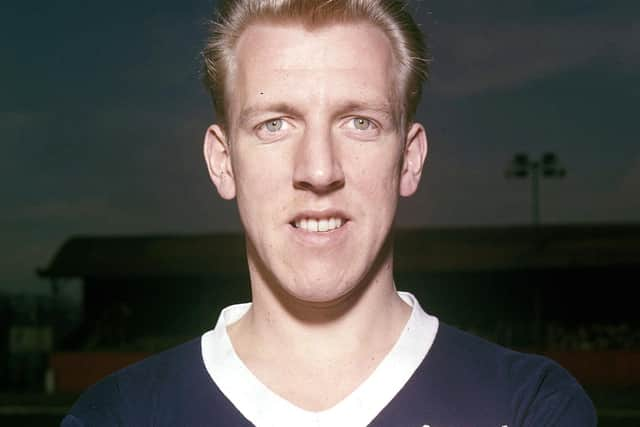Ian Ure on Arsenal days, Nick Hornby criticism, "cripple" signing for Manchester United and Rangers prodigy Robbie Ure


“Players who have played over 100 league games for Arsenal have created a club," he explains. "If I want to go, I get a ticket, as long as I let them know. They have put aside a little section at the Emirates.”
It seems the least he should expect. He gave everything, including his health to some extent, for a club he seemed magically drawn towards. Even while growing up in Ayrshire, when becoming a footballer was not even something that registered with him as a possibility, he felt a connection.
Advertisement
Hide AdAdvertisement
Hide Ad“That was my childhood club,” he says. “I do not know why. I did not contemplate for a moment until the age of 18 becoming a professional footballer. Not even remotely. But I remember as a wee boy for some reason Arsenal…and that is why I wanted to go there. I stuck out for it.”


He excelled at several sports, not just football. Future England cricket captain Mike Denness and Ian McLauchlan, the incomparable Scotland and British Lion prop, were Ayr Academy classmates and all three played in the same all-conquering rugby XV.
There must have been something in the water in Ayrshire at the time. Actually, there was something in the water in Ayrshire at the time. “We ran everywhere, we jumped stinky burns, we did all that, things kids don’t do now,” recalls Ure.
The "stinky burns" were so called because iron oxide was leaking out of the local steelworks. “It was dangerous,” adds Ure. “But I had a fabulous youth.
"We played sport for the love of it. I could have ended up playing junior football and been happy. I’d probably have been a PE teacher, I was semi-addicted to sport. I could turn my hands to most things. One of my claims to fame is that I won a bat in front of Mike Denness at Ayr Cricket Club. I was awarded bat of the year. I wish I’d kept the bat now.”


With Arsenal now back in his orbit it seems a good time to catch up once more with Ure, although when is it ever a bad time to hear his tales. His old club are at Ibrox, 25 miles up the M77 from his Kilmarnock home, this afternoon helping Rangers celebrate the club's 150th anniversary.
One of Ure's formative memories was watching football at Ibrox although it was the opposition with whom he would go on to enjoy legendary status. It was 2 January 1952. Ure was spellbound as visitors Dundee won 2-1.
“My old man took me to Ibrox once as a wee boy,” says the former centre-half. “Billy Steel scored a great goal. My dad and I were behind the goal. I still remember seeing the snow falling off the net as he cracked the ball in. My old man was a Rangers fanatic. He would have been chuffed to bits if I could ever have played for Rangers.”
Advertisement
Hide AdAdvertisement
Hide AdAmid all the focus on the long-standing links between Rangers and Arsenal, and Urehimself recalls playing in the fixture in the mid-60s, another potential connection has been identified. Robbie Ure has recently started creating a bit of profile for himself by scoring for the Rangers B team – he struck twice as recently as Wednesday in a 4-2 win over Burnley Under 23s.
It’s not a common name so those of a certain age have convinced themselves that Robbie must be a descendant of the footballing House of Ure. The lack of bouncy blond mound of hair, the older Ure’s trademark, suggested otherwise. And now indeed, Ure confirms no known tie to the Rangers young gun, who will lead the line today as the Ibrox side's B team make their controversial Lowland League debut against Bo’ness United.
Ure the younger will be doing well if he experiences half of what his namesake did. The list of achievements includes featuring for Scotland when they defeated Spain 6-2 in the Bernabeu in 1963.
Ure wishes all those starting out in the game well but envies only the wages they can now command. At best he earned £150 a week, and that was at Manchester United. He once calculated that John Terry earned more in three days than he did in his whole career.
An autobiography that was published in 1968, he says, “cost me money”, although it seems other people are doing OK out of it now. Second-hand copies of “Ure’s Truly” are now available on Amazon, starting at £30.
Such collectability underlines Ure’s one-time status. He twice broke the world record fee for a centre-half, initially when moving between Dundee and Arsenal for £62,500 and then, in 1969, when he was transferred to Manchester United for around £26,000 more. The book he is now more often associated with is much easier to get hold of since it’s regarded as a modern classic.
There is much to admire about Nick Hornby’s Fever Pitch, considered one of the finest books ever written about football, but the author’s condemnation of Ure is below the belt and ignorant. He all but pins the blame for a spell in therapy on the former centre-half.
Ure bats away such criticism with the ease of the cover drives he once performed for Ayr Cricket Club. When asked to appear on a late night arts programme with Hornby, he told the producers where to go. He had more important things to worry about. He became a social worker, based for a spell at Barlinnie Prison, following his playing days and after a brief spell in management, when he succeeded Alex Ferguson at East Stirlingshire.
Advertisement
Hide AdAdvertisement
Hide Ad“I have not read it,” he says of Fever Pitch. “I don’t remember the punters, the guys on the terracing, thinking that way about me. I thought I was one of the stalwarts.”
His 168 league appearances - hence his membership of the Arsenal 100 Club - supports this although he knows this number should be far greater.
He does admit that his performances at Highbury were compromised by a ruinous right knee injury, something which critics such as Hornby – who was only six when Ure made his Arsenal debut – should note before making withering comments. For the majority of his stay there, Ure estimates he was only 75 per cent the player he had been with Dundee.
He sustained the injury while being his usual fully committed self. He was a mainstay in 1963-64, his first full season at the club. Then came a fateful home clash with Aston Villa weeks into the following campaign.
“It was a block tackle with Tony Hateley, father of Mark,” he recalls. “It was a perfectly good tackle. I can see it now. I went in for a sliding tackle and he was running across the edge of the 18 yard line. He had the ball at his feet and I went in low and hard. I got the ball, but the impact was all on my knee. I got up and thought: ‘Oh oh, I have not had that before’. I did not like the feel of it.
"You think you're invincible at that age. You are that fit, running about. You think the world cannot beat you. But this cartilage certainly beat me.
“I had about four or five operations," he adds. "They did not give me long enough to rehabilitate, that was the trouble. I was back playing six weeks afterwards. The cartilage operation was pretty crude in those days. They cut your knee wide open. Nowadays they do pinhole surgery. The recovery time is so much better.
“It was my own fault really. I was impatient. A wee thing like a cartilage operation was not going to stop me. I wish they had just told me to go away, forget the season. I never recovered."
Advertisement
Hide AdAdvertisement
Hide AdSix weeks later he was playing for the reserves at Norwich. "At half-time there was a big balloon on the scar on my right knee. I said to the trainer: 'Bert, what’s the story here?' It was like a big chewing gum bubble. He said: 'Don’t worry about that’. He called for an ice bag."
Bert the trainer was Bertie Mee, who became manager shortly afterwards. Ure’s premature return put him out for another six weeks. “It was all downhill from then. It was all just swallow the pills and suffer the agony."
Ah, the pills. Ure later discovered that these pills had a dual use as horse tranquilisers. “They got you on the park to play,” he recalls. They were also later outlawed.
Arsenal’s doctor at the time, Dr Alan Bass, was a renowned Harley St consultant. “He used to point out my right knee’s X-rays and ask students: ‘how old do you think the man whose knee this is?’” says Ure. “Most of them said about 70.” Ure was in his late twenties.
He soldiered on. He played in two League Cup finals, both of which were lost. The second of these against third tier Swindon in 1969, when Arsenal lost 3-1 and he was involved in a mix-up for the first goal with goalkeeper Bob Wilson, added grist to the mill for those such as Hornby.
A defeat to Don Revie's Leeds United a year earlier proved arguably more painful, certainly literally so. “We gave them a doing and lost the game 1-0," recalls Ure. "It was one of those games. We outplayed them and they scored a goal. They were a dirty lot. It was orchestrated antagonism from that lot. They had kickers, hoofers, you name it. I did not like them at all.”
The Swindon result persuaded Arsenal it was time to cash in on Ure. “They ended up getting more than they paid for me!” he exclaims. Despite being, to use his own stark term, "a cripple", he commanded another landmark fee. The medical was no more thorough than having to bend his knee at a right angle. "Do that and I was in the team on Saturday!" he says.
It was farcical but at 29, with a family to feed, Ure was not about to request a more thorough medical exam. He quickly found he was not alone at Old Trafford in having seen better days. “It was a crumbling club,” he says.
Advertisement
Hide AdAdvertisement
Hide Ad“They were all knackered,” he says. “And there's me, a right donkey! I could sense it. I’d come from a team on the up, Arsenal were then in a transitional period and were getting young lads in.”
“George was the worst of all.” Best’s waning powers had more to do with his off the field activities than simple wear and tear. “He should have been dealt with,’ says Ure. “I would have got rid of him right away and you might still have got good money for him then.”
Ure gave Best a dressing down while on tour in America. “It was not not just me, Paddy Crerand was at him too. I was like: 'C'mon George, what’s the story here? We are supposed to be a team. He just shrugged his shoulders. He would not enter into a discussion. He knew he could get away with it."
Ure blames Matt Busby, by then general manager, for being too lax. The only manager he was particularly impressed by was Bob Shankly, who led Dundee to the Scottish title in 1962 and then the semi-final of the European Cup the following year.
Ure recalls going for a pee at half-time in the San Siro, where Dundee were holding AC Milan 1-1 in the first leg, and realising that his legs were shaking with the nervous energy of it all. Dundee were close but still so far away, as the loss of four second-half goals confirmed. Alan Gilzean's headed winner in the home leg counted for little but pride as Milan secure a place in the Wembley final.
Somehow, despite the frolicking in toxic streams in his youth and the horse tablets, Ure is still going strong at 81. After having his original damaged knee replaced in 2008, he had the other one replaced five weeks ago.
He is ever more alert to his advancing years as he considers the fate of the celebrated Dundee team in which he starred. Just three of that great XI remain – Ure, Bob Seith and goalkeeper Pat Liney, who turned 85 this week. He hopes they can partake in a mini reunion when the 60th anniversary of the title win is celebrated next April.
He watched Dundee win their Premiership play-off on television and was happy to see his old club secure a return to the top flight although, given that he can see Rugby Park from his house, he was slightly torn. He plans to be in attendance when Kilmarnock kick off their Championship campaign against his hometown club Ayr United in an eagerly awaited Ayrshire derby.
Advertisement
Hide AdAdvertisement
Hide AdAs for Dundee, he laments the quality compared to his time at Dens, but then few teams could withstand such a comparison. Charlie Adam merits an honorary mention.
“We would have murdered them!” he says. “There’s one player who could possibly have played, Charlie. He’s an old-fashioned player. He would have been ideal in midfield.”
He imagines Gilzean feasting off his deliveries. “I think you could have played him in midfield with the two Bobbys, Seith and Wishart.” Asked who would have to be left out to accommodate Adam, he’s stumped. “Maybe put he’d only make the pool, then,” he says.
A message from the Editor:Thank you for reading this article. We're more reliant on your support than ever as the shift in consumer habits brought about by Coronavirus impacts our advertisers.If you haven't already, please consider supporting our trusted, fact-checked journalism by taking out a digital subscription H https://www.scotsman.com/subscriptions
Comments
Want to join the conversation? Please or to comment on this article.